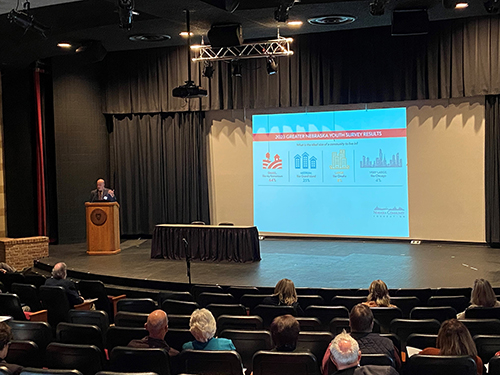Economic development has changed, and community colleges are taking on an expanded role.
That was one of the messages Nov. 6 during the Nebraska Community College Association (NCCA) annual conference in North Platte.
K.C. Belitz, director of the Nebraska Department of Economic Development, said the old approach to economic development was for communities to offer three assets: cheap land, cheap labor and big incentives. Belitz was the keynote speaker to open the conference.
The new approach is “Growing Our Own,” which includes keeping Nebraskans at home. That means talent-driven economic development because workers can get jobs anywhere. It is more about where workers want to locate, Belitz said.
Before Belitz was appointed to his current position by Gov. Jim Pillen, he was the chief operating officer of the Nebraska Community Foundation. He also served nearly two decades as president of the Columbus Area Chamber of Commerce, which grew into the state’s third largest chamber during his tenure.
Belitz said one of the things he noticed in Columbus was that when industries were looking to expand or locate in the community, they often spoke first to the community college. They were interested in seeing what training programs were available or what training programs could be made available for potential employers so the workforce could have the needed skills.
Community colleges’ role in economic development is more important now than ever as employers in Nebraska look to find employees who can fill their jobs. It is estimated that about 50,000 to 80,000 jobs are unfilled right now in Nebraska, but Belitz said it could easily be 200,000 jobs – based in part if those vacant jobs were filled leading to spinoff jobs and other factors associated with the tight labor market.
And remarkably, Nebraska is better off than most states.
Belitz said Nebraska currently has the third highest workforce participation rate in the nation and has had the highest at times in recent years.
Here are some other pluses for Nebraska:
• It has the sixth highest birth rate.
• The Cornhusker state has the third highest percentage of children under 18, which indicates it is a young state.
• There is “brain gain.” More students come in for their first year of college than leave the state.
And based on surveys of young people, Nebraska already offers what young people want – especially the top three, Belitz said.
Surveys indicate that young people seek: 1. Safety from violence, theft; 2. Good schools; 3. Proximity to family. Other attributes that ranked near the top for young people are diverse cultural experiences, entertainment and shopping.
Belitz said the most significant reason Nebraska doesn’t get more young people staying in their hometowns is because they don’t think they can get a job in their hometowns. A survey indicated that 52% of young people thought they could not.
While a young person who wants to be an oceanographer is going to have difficulty finding that job in Nebraska, most jobs aren’t suited to the ocean or mountains. Instead, some jobs might need some tweaking, but they already exist in Nebraska hometowns, Belitz said.
At the Department of Economic Development, workforce development is “Job 1,” he said.
“Community colleges have never been more relevant to economic development than they are today,” he said.
Belitz pointed out that high tech industry already is in Nebraska and more is on the way. That includes the iHub robotics center Northeast is constructing in downtown Norfolk. Northeast also is among the community colleges working to meet the growing need of more CDL licensed truck drivers and welders. That includes breaking ground on a new facility in South Sioux City, Belitz said.
One obstacle in just about every community, however, is finding enough housing – especially housing that is affordable.
Belitz said the state fell behind in housing for a couple of decades. Now, not only is it working to try and catch up, but it must also meet the need for future growth.
Among the ways to solve that issue is reducing the number of barriers and regulations that hinder housing. That’s been one of the areas that Gov. Pillen is working to address, Belitz said.
Community colleges also can play a role in solving the housing shortage by helping to bring skilled workers to the housing industry.
Another challenge is childcare. Many communities are working on this issue. Solving it will include public and private partnerships, investments in childcare facilities and recruiting early childhood educators.
There has never been this type of window of opportunity in the state for growth. Unfortunately, windows don’t remain open indefinitely, so it is important to spread the word about what Nebraska offers and the opportunities that are ahead, Belitz said.
“Today’s youth may be the most receptive audience we’ve had in 100 years,” Belitz said. “They’re very open to launching a career and raising a family in Nebraska – provided we can show them a pathway to stay.”
Community colleges are a big part of putting together the puzzle that lies ahead for economic development, he said.
###
NCCA keynote cutline
K.C. Belitz discusses economic development, and all the positives Nebraska has going for it during the Nebraska Community College Association conference in North Platte on Nov. 6.

